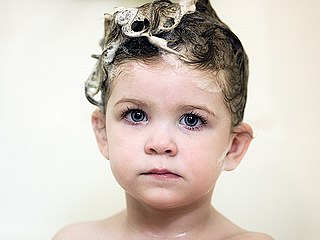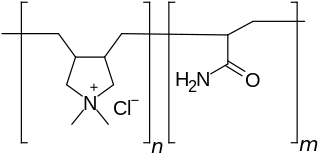This article needs additional citations for verification .(January 2017) |
Polyquaternium is the International Nomenclature for Cosmetic Ingredients designation for several polycationic polymers that are used in the personal care industry. Polyquaternium is a neologism used to emphasize the presence of quaternary ammonium centers in the polymer. INCI has approved at least 40 different polymers under the polyquaternium designation. Different polymers are distinguished by the numerical value that follows the word "polyquaternium". Polyquaternium-5, polyquaternium-7, and polyquaternium-47 are three examples, each a chemically different type of polymer. The numbers are assigned in the order in which they are registered rather than because of their chemical structure.
Polyquaterniums find particular application in conditioners, shampoo, hair mousse, hair spray, hair dye, personal lubricant, and contact lens solutions. Because they are positively charged, they neutralize the negative charges of most shampoos and hair proteins and help hair lie flat. Their positive charges also ionically bond them to hair and skin. Some have antimicrobial properties.
| Polyquaternium | Chemical Identity |
|---|---|
| Polyquaternium-1 | Ethanol, 2,2′,2″ -nitrilotris-, polymer with 1,4-dichloro-2-butene and N,N,N′,N′-tetramethyl-2-butene-1,4-diamine |
| Polyquaternium-2 | Poly[bis(2-chloroethyl) ether-alt-1,3-bis[3-(dimethylamino)propyl]urea] |
| Polyquaternium-4 | Hydroxyethyl cellulose dimethyl diallylammonium chloride copolymer; Diallyldimethylammonium chloride-hydroxyethyl cellulose copolymer |
| Polyquaternium-5 | Copolymer of acrylamide and quaternized dimethylammoniumethyl methacrylate |
| Polyquaternium-6 | Poly(diallyldimethylammonium chloride) |
| Polyquaternium-7 | Copolymer of acrylamide and diallyldimethylammonium chloride |
| Polyquaternium-8 | Copolymer of methyl and stearyl dimethylaminoethyl ester of methacrylic acid, quaternized with dimethylsulphate [2] |
| Polyquaternium-9 | Homopolymer of N,N-(dimethylamino)ethyl ester of methacrylic acid, quaternized with bromomethane |
| Polyquaternium-10 | Quaternized hydroxyethyl cellulose |
| Polyquaternium-11 | Copolymer of vinylpyrrolidone and quaternized dimethylaminoethyl methacrylate |
| Polyquaternium-12 | Ethyl methacrylate / abietyl methacrylate / diethylaminoethyl methacrylate copolymer quaternized with dimethyl sulfate |
| Polyquaternium-13 | Ethyl methacrylate / oleyl methacrylate / diethylaminoethyl methacrylate copolymer quaternized with dimethyl sulfate |
| Polyquaternium-14 | Trimethylaminoethylmethacrylate homopolymer |
| Polyquaternium-15 | Acrylamide-dimethylaminoethyl methacrylate methyl chloride copolymer |
| Polyquaternium-16 | Copolymer of vinylpyrrolidone and quaternized vinylimidazole |
| Polyquaternium-17 | Adipic acid, dimethylaminopropylamine and dichloroethylether copolymer |
| Polyquaternium-18 | Azelaic acid, dimethylaminopropylamine and dichloroethylether copolymer |
| Polyquaternium-19 | Copolymer of polyvinyl alcohol and 2,3-epoxypropylamine |
| Polyquaternium-20 | Copolymer of polyvinyl octadecyl ether and 2,3-epoxypropylamine |
| Polyquaternium-22 | Copolymer of acrylic acid and diallyldimethylammonium Chloride |
| Polyquaternium-24 | Quaternary ammonium salt of hydroxyethyl cellulose reacted with a lauryl dimethyl ammonium substituted epoxide. |
| Polyquaternium-27 | Block copolymer of Polyquaternium-2 and Polyquaternium-17 |
| Polyquaternium-28 | Copolymer of vinylpyrrolidone and methacrylamidopropyl trimethylammonium |
| Polyquaternium-29 | Chitosan modified with propylen oxide and quaternized with epichlorhydrin |
| Polyquaternium-30 | Ethanaminium, N-(carboxymethyl)-N,N-dimethyl-2-[(2-methyl-1-oxo-2-propen-1-yl)oxy]-, inner salt, polymer with methyl 2-methyl-2-propenoate |
| Polyquaternium-31 | N,N- dimethylaminopropyl-N-acrylamidine quatemized with diethylsulfate bound to a block of polyacrylonitrile |
| Polyquaternium-32 | Poly(acrylamide 2-methacryloxyethyltrimethyl ammonium chloride) |
| Polyquaternium-33 | Copolymer of trimethylaminoethylacrylate salt and acrylamide |
| Polyquaternium-34 | Copolymer of 1,3-dibromopropane and N,N-diethyl-N′,N′-dimethyl-1,3-propanediamine |
| Polyquaternium-35 | Methosulphate of the copolymer of methacryloyloxyethyltrimethylammonium and of methacryloyloxyethyldimethylacetylammonium |
| Polyquaternium-36 | Copolymer of N,N-dimethylaminoethylmethacrylate and buthylmethacrylate, quaternized with dimethylsulphate |
| Polyquaternium-37 | Poly(2-methacryloxyethyltrimethylammonium chloride) |
| Polyquaternium-39 | Terpolymer of acrylic acid, acrylamide and diallyldimethylammonium Chloride |
| Polyquaternium-42 | Poly[oxyethylene(dimethylimino)ethylene (dimethylimino)ethylene dichloride] |
| Polyquaternium-43 | Copolymer of acrylamide, acrylamidopropyltrimonium chloride, 2-amidopropylacrylamide sulfonate and dimethylaminopropylamine |
| Polyquaternium-44 | 3-Methyl-1-vinylimidazolium methyl sulfate-N-vinylpyrrolidone copolymer |
| Polyquaternium-45 | Copolymer of (N-methyl-N-ethoxyglycine)methacrylate and N,N-dimethylaminoethylmethacrylate, quaternized with dimethyl sulphate |
| Polyquaternium-46 | Terpolymer of vinylcaprolactam, vinylpyrrolidone, and quaternized vinylimidazole |
| Polyquaternium-47 | Terpolymer of acrylic acid, methacrylamidopropyl trimethylammonium chloride, and methyl acrylate |













